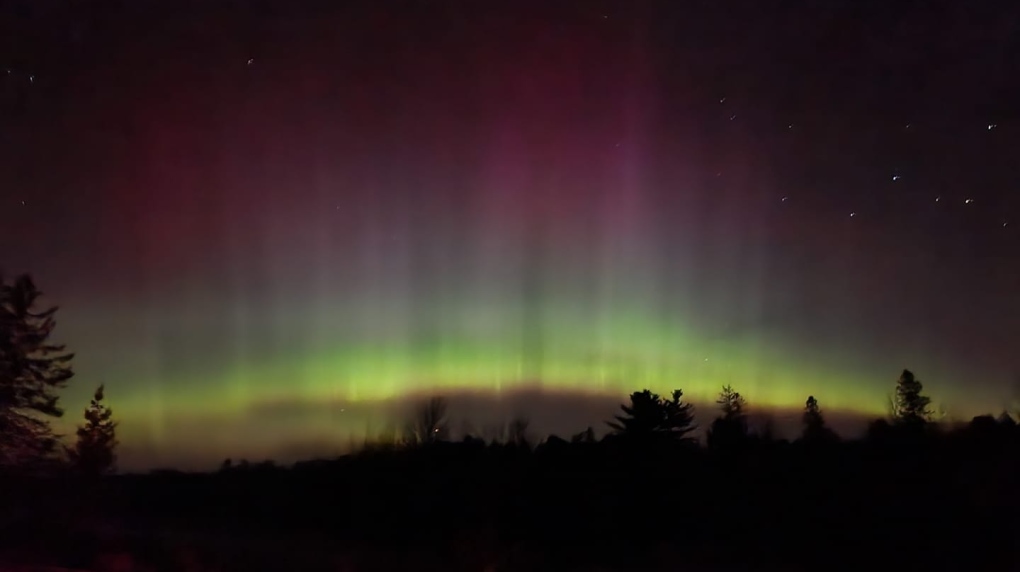Geomagnetic storm could bring aurora viewing in the Maritimes Thursday night
 A photo of the aurora borealis courtesy of Brandy Flynn-Dolliver taken near Rawdon, N.S., on April 23, 2023.
A photo of the aurora borealis courtesy of Brandy Flynn-Dolliver taken near Rawdon, N.S., on April 23, 2023.
The Space Weather Prediction Center of the United States is predicting the likely occurrence of a strong geomagnetic storm Thursday night, creating an aurora active enough it could be spotted in the Maritimes.
A geomagnetic storm is the interaction of the Earth’s magnetic field with highly energized particles emitted from the Sun during a coronal mass ejection.
The conditions can interfere with radio frequencies, GPS systems, and in some cases cause power system issues. It also produces spectacular aurora borealis displays that can often been seen at latitudes much further south than typical.
 The Kp index forecast for Thursday night by the Space Weather Prediction Center of the U.S.
The Kp index forecast for Thursday night by the Space Weather Prediction Center of the U.S.
One of the ways the strength of a geomagnetic storm is rated is through the Kp-index. The Kp-index rates 0-9, with 0 being calm, minor geomagnetic storm conditions staring at 5, and strong geomagnetic storm conditions starting at 7.
The Kp-index is forecast by the organization to reach 7 around 2 a.m. Friday Atlantic time. In the past, observed Kp-index values of 5 to 7+ have been associated with a visible aurora display in the Maritimes. For Thursday night, it appears the best time to try and catch a glimpse of the aurora is generally between midnight and dawn.
 Partly cloudy with chilly temperatures forecast for Thursday night and the pre-dawn hours of Friday.
Partly cloudy with chilly temperatures forecast for Thursday night and the pre-dawn hours of Friday.
The sky conditions during that time won’t be perfectly clear. Some broken cloud is expected to be over the region Thursday night. Breaks of clear night sky look most likely for southern and eastern areas of New Brunswick, Prince Edward Island, and mainland Nova Scotia. It will be a chilly night with low temperatures ranging a few degrees below to a few degrees above freezing.
To give yourself the best chance of viewing you would want to go to a location away from city and town lights. Look towards the north and lower on the horizon. Have patience and realize that, even if visible, the aurora may be on the fainter side. Like terrestrial weather, space weather can throw a curve ball at predictions. I’ve see situations in the past when a stronger geomagnetic storm was forecast, but failed to materialize into a visible aurora display.
CTVNews.ca Top Stories

Indian envoy warns of 'big red line,' days after charges laid in Nijjar case
India's envoy to Canada insists relations between the two countries are positive overall, despite what he describes as 'a lot of noise.'
Stormy Daniels describes meeting Trump during occasionally graphic testimony in hush money trial
With Donald Trump sitting just feet away, Stormy Daniels testified Tuesday at the former president's hush money trial about a sexual encounter the porn actor says they had in 2006 that resulted in her being paid to keep silent during the presidential race 10 years later.
U.S. paused bomb shipment to Israel to signal concerns over Rafah invasion, official says
The U.S. paused a shipment of bombs to Israel last week over concerns that Israel was approaching a decision on launching a full-scale assault on the southern Gaza city of Rafah against the wishes of the U.S.
Former homicide detective explains how police will investigate shooting outside Drake's Bridle Path mansion
Footage from dozens of security cameras in the area of Drake’s Bridle Path mansion could be the key to identifying the suspect responsible for shooting and seriously injuring a security guard outside the rapper’s sprawling home early Tuesday morning, a former Toronto homicide detective says.
Northern Ont. woman makes 'eggstraordinary' find
A chicken farmer near Mattawa made an 'eggstraordinary' find Friday morning when she discovered one of her hens laid an egg close to three times the size of an average large chicken egg.
Susan Buckner, who played spirited cheerleader Patty Simcox in 'Grease,' dead at 72
Susan Buckner, best known for playing peppy Rydell High School cheerleader Patty Simcox in the 1978 classic movie musical 'Grease,' has died. She was 72.
Jeremy Skibicki has 'uphill battle' to prove he's not criminally responsible in Winnipeg killings: legal analysts
Accused killer Jeremy Skibicki could have a challenging time convincing a judge that he is not criminally responsible for the deaths of four Indigenous women, a legal analyst says.
Bye-bye bag fee: Calgary repeals single-use bylaw
A Calgary bylaw requiring businesses to charge a minimum bag fee and only provide single-use items when requested has officially been tossed.
Alcohol believed to be a factor in boating incident after 2 men die: N.S. RCMP
Two Nova Scotia men are dead after a boat they were travelling in sank in the Annapolis River in Granville Centre, N.S., on Monday.
































